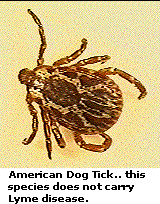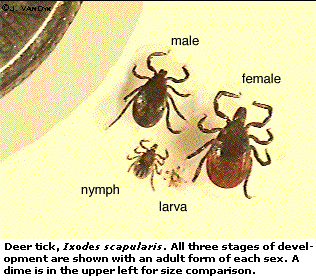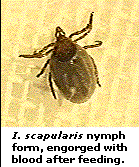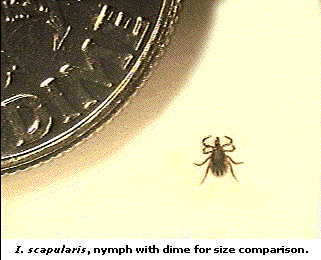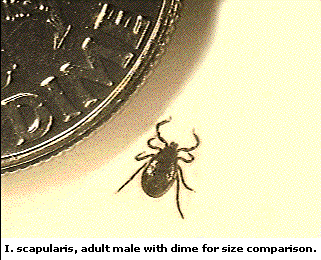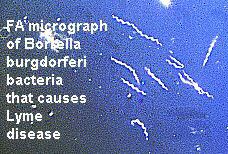|
Clinical Features
 The
clinical features of Lyme disease may be discussed as three
distinct stages, although an enormous amount of overlap
exists between stages and only one or two stages may be
evident in a given case. The
clinical features of Lyme disease may be discussed as three
distinct stages, although an enormous amount of overlap
exists between stages and only one or two stages may be
evident in a given case.
 Stage
I begins 3 days to 3 weeks after exposure. Erythema migrans
(EM) is the characteristic finding in Stage I. This is a
bright, expanding patch of redness that tends to clear in
the middle as it enlarges with a sharply defined border. As
the center clears, it may develop a bluish color. Lesions
can attain a diameter as large as 50 cm. and are usually
located on the trunk or proximal part of an extremity. In
about 60% to 80% of cases this is the presenting
symptom. Stage
I begins 3 days to 3 weeks after exposure. Erythema migrans
(EM) is the characteristic finding in Stage I. This is a
bright, expanding patch of redness that tends to clear in
the middle as it enlarges with a sharply defined border. As
the center clears, it may develop a bluish color. Lesions
can attain a diameter as large as 50 cm. and are usually
located on the trunk or proximal part of an extremity. In
about 60% to 80% of cases this is the presenting
symptom.
 Multiple
lesions are fairly common; where these occur, one spot is
usually clearly older than the others. About half the cases
in Stage I will have a flu-like illness with fever,
headache, stiff neck, arthralgia, and myalgia. Lymph node
enlargement in the area of the EM is common. The primary
illness may last from a few days to a few weeks. In rare
cases the EM persists several months before resolving.
Variations in the appearance of the skin lesions are not
uncommon, and atypical presentations of the rash may be
vesicular lesions, or appear to be cellulitis. Also, the
rash may not be apparent, and may not be noticed at
all. Multiple
lesions are fairly common; where these occur, one spot is
usually clearly older than the others. About half the cases
in Stage I will have a flu-like illness with fever,
headache, stiff neck, arthralgia, and myalgia. Lymph node
enlargement in the area of the EM is common. The primary
illness may last from a few days to a few weeks. In rare
cases the EM persists several months before resolving.
Variations in the appearance of the skin lesions are not
uncommon, and atypical presentations of the rash may be
vesicular lesions, or appear to be cellulitis. Also, the
rash may not be apparent, and may not be noticed at
all.
 Stage
II disease usually begins weeks to months later (but may
occur earlier). Up to 8% of patients experience transient
cardiac dysfunction. Varying degrees of atrioventricular
block, including complete heart block, are more common than
myocarditis and left ventricular dysfunction. Neurologic
abnormalities include headache, profound fatigue,
meningitis, cranial neuropathies (especially facial
palsies), and sensory and motor radiculopathies. Some
combination of neurologic symptoms is present in about
one-third of cases. Other organs that are occasionally
involved include lung, muscle, bone, liver, subcutaneous
fat, and eye. Stage
II disease usually begins weeks to months later (but may
occur earlier). Up to 8% of patients experience transient
cardiac dysfunction. Varying degrees of atrioventricular
block, including complete heart block, are more common than
myocarditis and left ventricular dysfunction. Neurologic
abnormalities include headache, profound fatigue,
meningitis, cranial neuropathies (especially facial
palsies), and sensory and motor radiculopathies. Some
combination of neurologic symptoms is present in about
one-third of cases. Other organs that are occasionally
involved include lung, muscle, bone, liver, subcutaneous
fat, and eye.
 Stage
III may involve joints, the central nervous system, and
skin. Arthritis can develop a few days to several years
after Stage I, but most commonly a few weeks to months after
the initial illness. At least one episode of arthritis
occurs in about 60% of patients with untreated EM. The
arthritis is usually asymmetric, with involvement of one or
a few joints, often migratory, with a predilection for large
joints, especially knees. Attacks may last days to weeks,
with asymptomatic periods of weeks to months. Although
attacks tend to become less frequent over time and
eventually disappear, a chronic arthritis occurs about 10%
of the time. Chronic neurologic disease may develop either
as a late manifestation or as a continuation of secondary
disease. Chronic neurologic problems may include fatigue,
chronic encephalomyelitis, paraparesis, ataxia,
radiculopathies, depression and dementia. Acrodermatitis
chronica atrophicans and lymphocytoma may develop as
tertiary skin manifestations. In Europe, skin and neurologic
manifestations are more common, and arthritis is less
common, than in the United States. Stage
III may involve joints, the central nervous system, and
skin. Arthritis can develop a few days to several years
after Stage I, but most commonly a few weeks to months after
the initial illness. At least one episode of arthritis
occurs in about 60% of patients with untreated EM. The
arthritis is usually asymmetric, with involvement of one or
a few joints, often migratory, with a predilection for large
joints, especially knees. Attacks may last days to weeks,
with asymptomatic periods of weeks to months. Although
attacks tend to become less frequent over time and
eventually disappear, a chronic arthritis occurs about 10%
of the time. Chronic neurologic disease may develop either
as a late manifestation or as a continuation of secondary
disease. Chronic neurologic problems may include fatigue,
chronic encephalomyelitis, paraparesis, ataxia,
radiculopathies, depression and dementia. Acrodermatitis
chronica atrophicans and lymphocytoma may develop as
tertiary skin manifestations. In Europe, skin and neurologic
manifestations are more common, and arthritis is less
common, than in the United States.
Page
16
|
